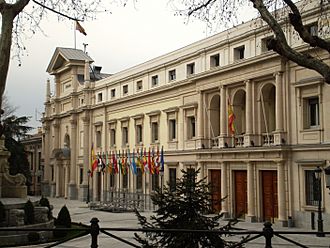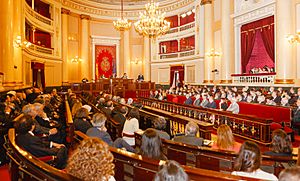Palacio del Senado facts for kids
Quick facts for kids Palace of the Senate |
|
|---|---|
|
Palacio del Senado
|
|

Facade of the Palace, Madrid, Spain
|
|
| Former names | Incarnation School Doña María de Aragón School |
| General information | |
| Architectural style | Herrerian, Neoclassical |
| Town or city | Madrid |
| Country | Spain |
| Coordinates | 40°25′16″N 3°42′43″W / 40.421183°N 3.711817°W |
| Current tenants | Senate of Spain |
| Estimated completion | 16th century |
| Renovated | 19th and 20th century |
| Client | Cortes Generales |
| Owner | Kingdom of Spain |
| Design and construction | |
| Architect | Francisco de Montalbán (original) Aníbal Álvarez Bouquel and Emilio Rodríguez Ayuso (19th renovation) Salvador Gayarre Ruiz de Galarreta (20th renovation) |
The Palace of the Senate is a very important building in Madrid, Spain. It's where the Senate of Spain meets. The Senate is like the "upper house" of Spain's parliament, which is called the Cortes Generales. Think of it as one of the two main groups of lawmakers who help run the country. This historic palace is right in the center of Madrid.
Contents
History of the Palace
From School to Parliament
The Palace of the Senate was built a long time ago, in the 1500s. Back then, it wasn't a government building. It was a school run by a religious group called the Saint Augustine Order. The school was known as the Incarnation School or Doña María de Aragón School. It was a very important school in Madrid. Its church even had famous paintings by the artist El Greco, which you can now see in the Prado Museum.
Spain's First Parliament
Later, in the early 1800s, the building became a place for important political meetings. From 1814 to 1823, it was home to the Cortes of Cádiz. This was Spain's very first official parliament. It was a big step for the country!
Home of the Upper House
In 1834, Spain set up a new parliament called the Cortes Generales. This parliament had two parts, like many governments today. One part was called the Chamber of Peers, which was the "upper house." In 1835, the Chamber of Peers moved into this palace. Even though its name and powers changed over the years, the palace continued to be the home of Spain's upper house until 1923.
Times of Change
Spain went through some big changes in the 20th century. During a time when Spain was ruled by a dictator (from 1923 to 1930), the parliament was closed. A new group was formed, but it met in a different building.
When Spain became a republic (the Second Spanish Republic), the main parliament moved to the Palacio de las Cortes. Important discussions about the country's new rules happened in another building, the Palacio de Cristal del Retiro.
Later, during another period when Spain was ruled by a dictator, the palace was used by a group called the National Council of the Movement. This group was like a "pseudo-Senate" and was controlled by the dictator.
Return to Democracy
In 1977, Spain became a democracy again. The Senate was brought back and moved into its original home, the Palace of the Senate. Along with another part of the parliament, the Congress of Deputies, they worked together to write Spain's democratic Constitution of 1978. This important document set out the rules for how Spain would be governed as a free country.
See also
 In Spanish: Palacio del Senado (España) para niños
In Spanish: Palacio del Senado (España) para niños


